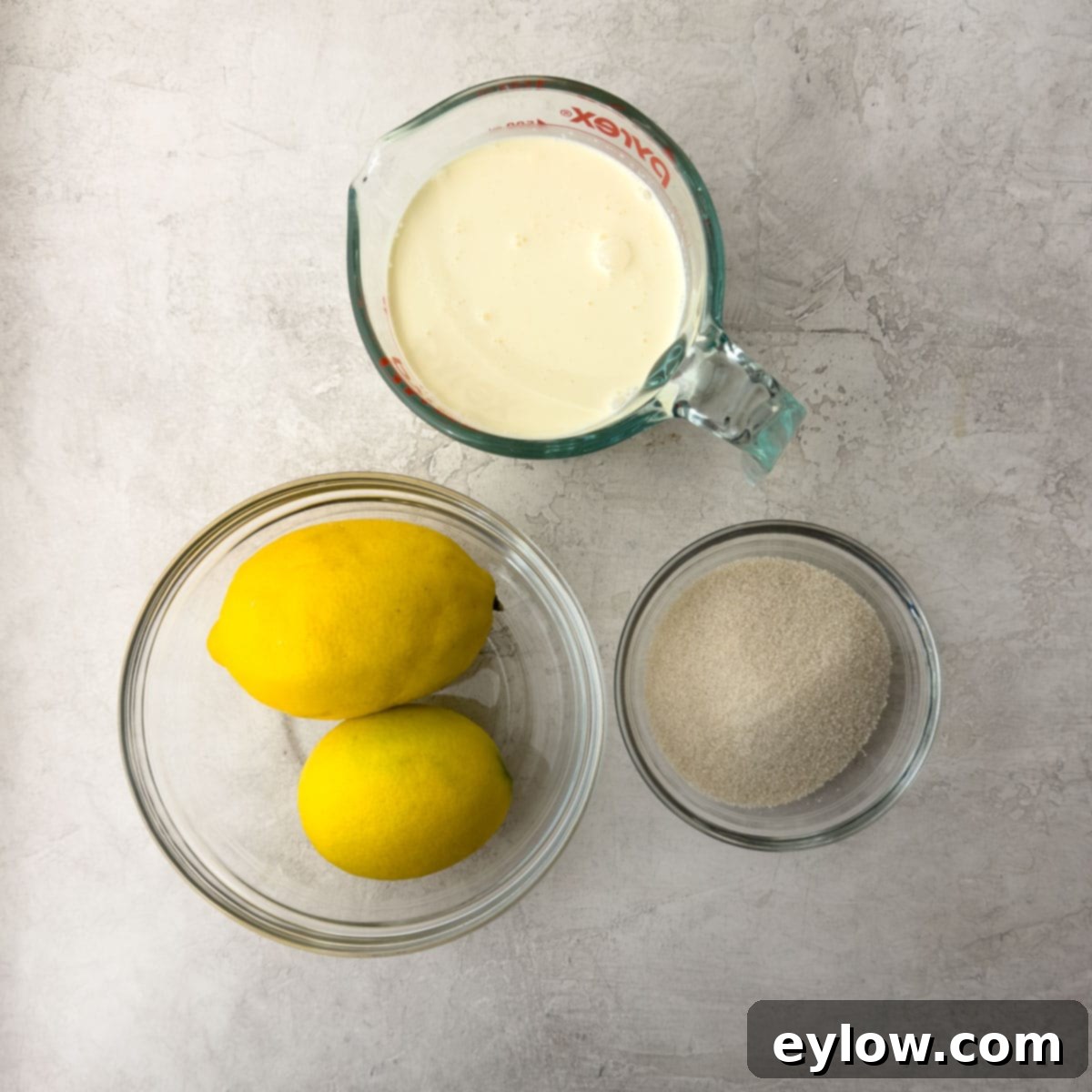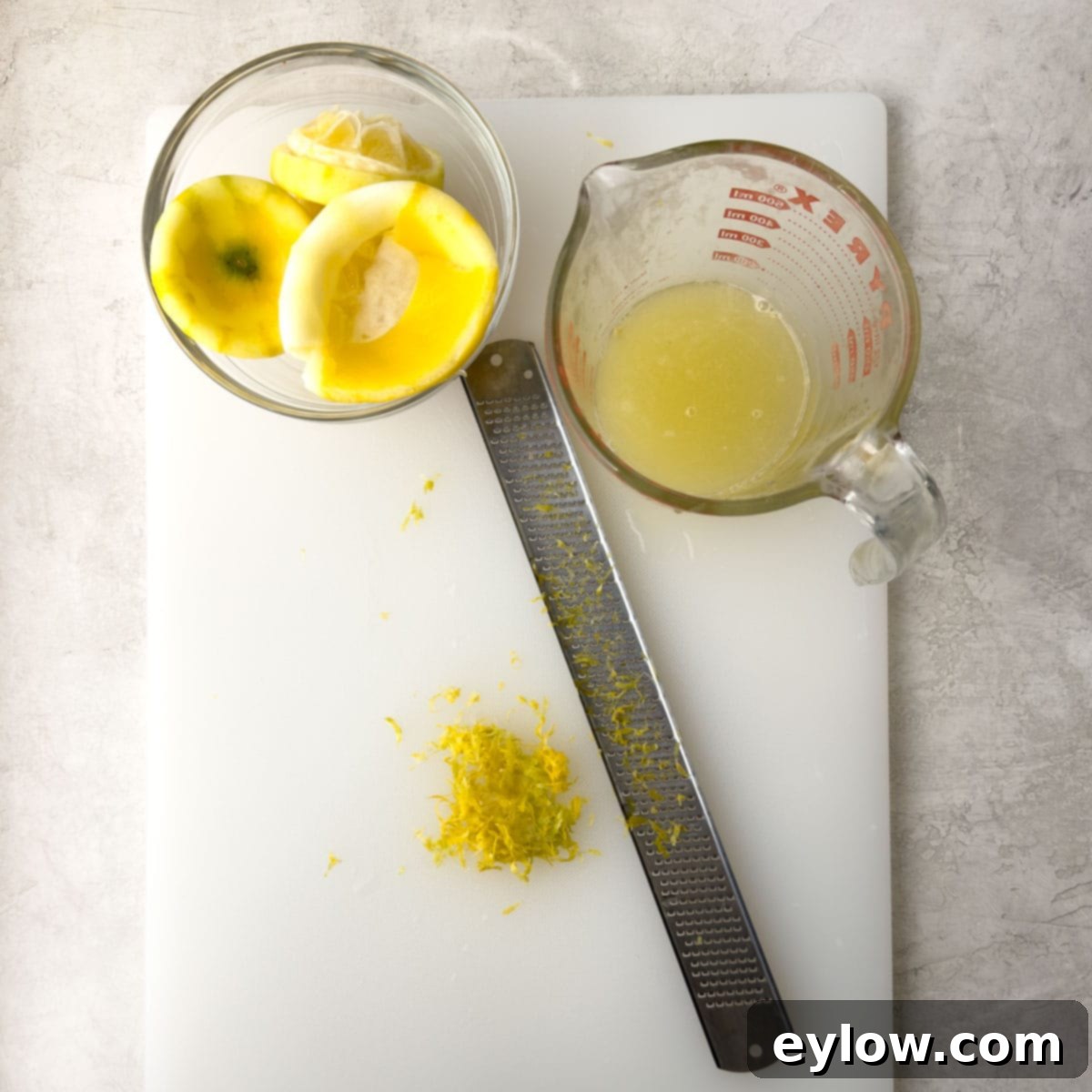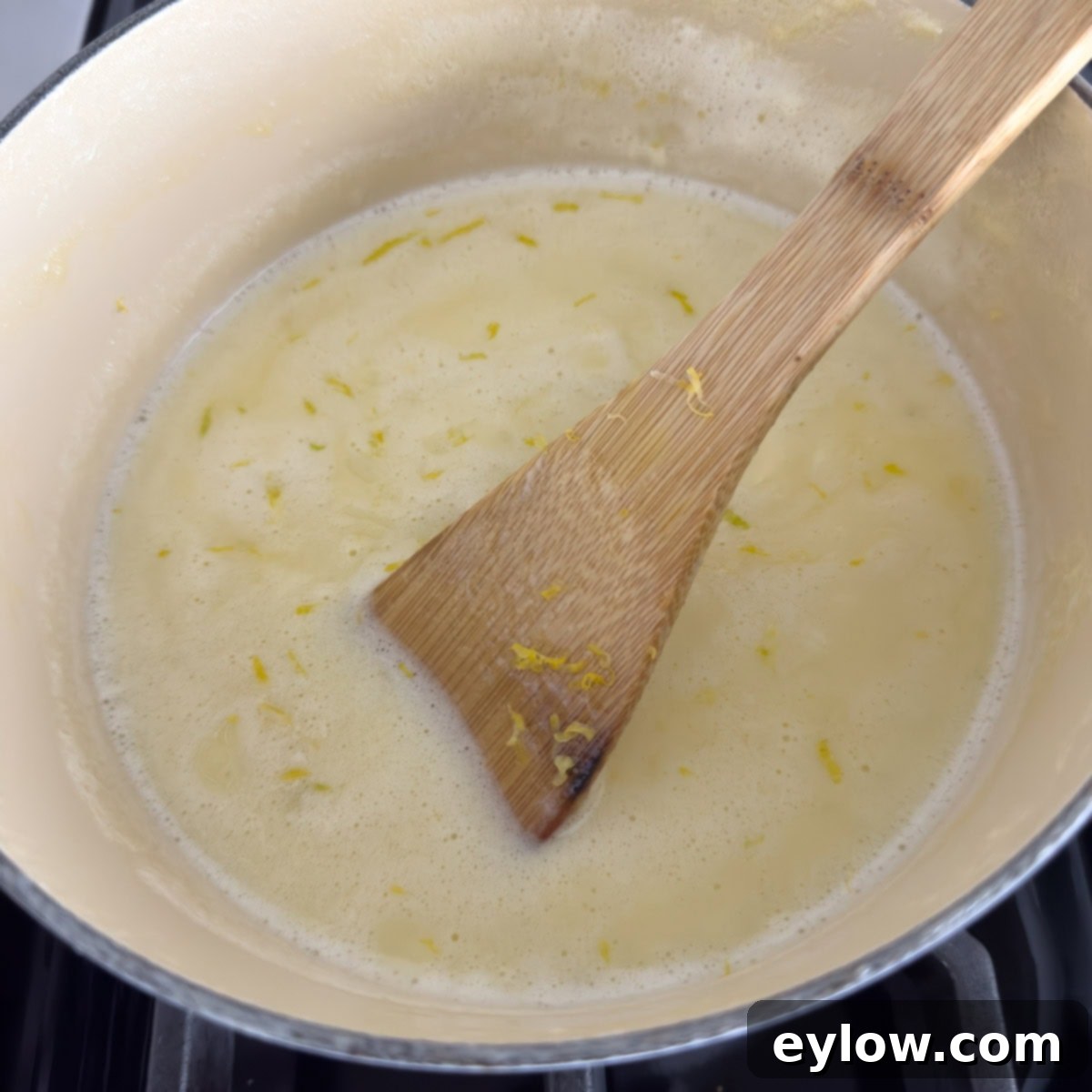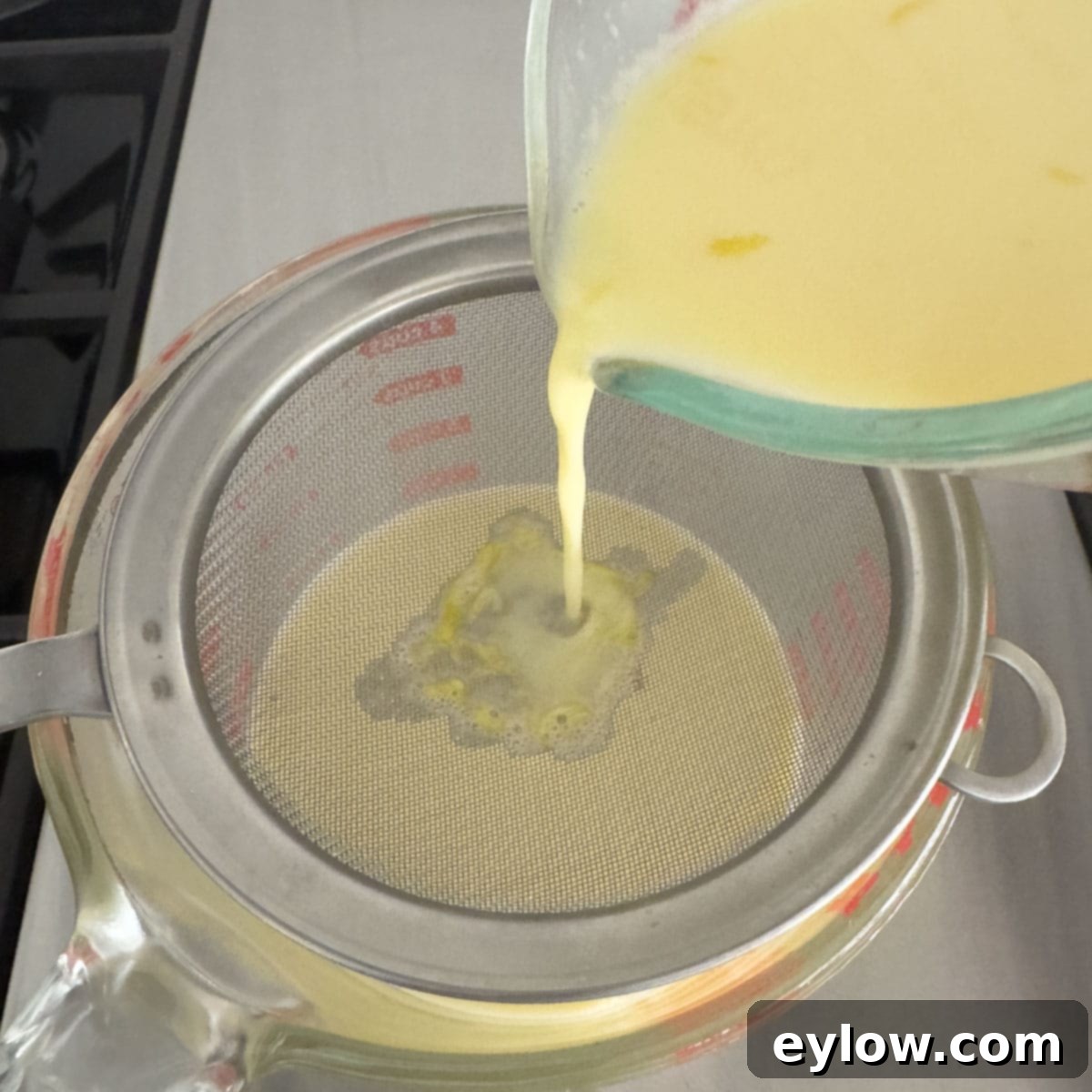Luscious Lemon Posset: An Easy 3-Ingredient No-Bake Dessert
Prepare to discover a delightful dessert you might have overlooked: the classic chilled cream dessert known as Posset. This recipe focuses on a luscious, custard-style lemon posset, an incredibly simple treat that requires just minutes of preparation and only three core ingredients. If you’re a fan of bright, creamy, and effortlessly elegant lemon desserts, this recipe is an absolute must-try. It’s a guaranteed crowd-pleaser and has certainly become one of my personal favorites. The best part? No baking is required, making it ideal for any occasion.

As a true lemon enthusiast, I’m always eager to explore new ways to incorporate its vibrant flavor into my cooking. Whether it’s savory dishes like grilled lemon mint chicken or a refreshing lemony Mediterranean pasta salad, or sweet indulgences like a lemon olive oil cake, I’m all in. If you share this love for citrus, then you are going to adore this easy lemon posset recipe. When friends who adore lemon desserts were coming over for dinner, I immediately knew what to whip up. This simple yet sophisticated lemon posset is a fantastic addition to your dessert recipe collection, and I find myself looking forward to making it again and again.
Why You’ll Adore This Easy Lemon Posset Recipe
This lemon posset isn’t just a dessert; it’s a culinary revelation. Its simplicity combined with its exquisite taste makes it an irresistible choice for both casual family meals and elegant dinner parties. Here’s why this easy lemon posset recipe will quickly become a cherished favorite:
- Effortless Make-Ahead: This is the ultimate stress-free dessert! You can prepare your lemon possets at least 4 hours in advance, or even the night before, allowing the flavors to meld and the cream to set perfectly. This flexibility means you can focus on other aspects of your meal or simply enjoy your guests without last-minute dessert preparations.
- Bursting with Lemon Flavor: Each spoonful delivers an intense, luscious lemon flavor that is both bright and comforting. The creamy texture, reminiscent of a silky custard or a delicate panna cotta, provides a luxurious mouthfeel that truly elevates the simple ingredients. It’s perfectly balanced—tangy enough to awaken your palate, but sweet enough to satisfy any dessert craving.
- Just 3 Simple Ingredients: You read that right! With only heavy cream, fresh lemons, and sugar, you can create this elegant dessert. This minimal ingredient list makes it incredibly accessible and proves that extraordinary flavors don’t require complex components.
- Perfect for Entertaining: Whether you’re hosting a sophisticated dinner party or a casual get-together, lemon posset presents beautifully in individual ramekins or glasses, making it an elegant and portion-controlled dessert that’s sure to impress your guests. Its refreshing profile is particularly delightful after a rich meal.
- Super Easy Recipe: Forget complicated techniques and long baking times. This recipe is straightforward, involving just a few steps: simmering the cream, adding the lemon, and chilling. Even novice cooks can achieve perfect results, making it an excellent choice when you want maximum impact with minimum effort.
For another much-loved creamy lemon dessert that’s light as air, be sure to try this Italian lemon almond mousse. It offers a different, yet equally delightful, texture and flavor experience.
Essential Lemon Posset Ingredients
Creating the perfect lemon posset relies on the quality of just a few key ingredients. Here’s a closer look at what you’ll need and why each component is crucial for achieving that irresistible creamy, tangy perfection:

- Heavy Cream: This is the backbone of your posset. Whether labeled “heavy cream” or “heavy whipping cream,” they are essentially the same. The critical factor is its fat content, which should be between 36% to 40% butterfat. This high fat percentage is absolutely essential because the lemon juice reacts with the cream’s proteins and fat to create the thickened, custard-like texture. Do not substitute with half-and-half, light cream, or milk, as they lack the necessary fat to properly set the posset.
- Lemons: Fresh lemons are paramount here, serving as both the primary flavor agent and the crucial acidic component that thickens the heavy cream. You’ll need both fresh lemon juice and vibrant lemon zest. The zest provides aromatic oils for a deeper lemon flavor, while the juice’s acidity is the “magic” that transforms the cream into a posset. I often use Meyer lemons for their slightly sweeter, less acidic profile, but any standard lemon variety works beautifully. If your lemon juice is exceptionally tart, you might find a touch more sugar is needed to balance the flavors.
- Citric Acid: This ingredient is only needed if you are using lower-acid lemons, such as Meyer lemons. The acid is the main coagulating agent in a posset, and insufficient acidity can prevent the cream from setting fully. Citric acid in powdered form acts as a reliable boost, ensuring your posset achieves the perfect consistency. It’s typically available in the baking aisle of some grocery stores or can be easily ordered online.
- Sweetener (Sugar): Granulated sugar is the standard sweetener for a classic lemon posset, providing the necessary balance to the lemon’s tartness. If you have superfine sugar (also known as caster sugar), it’s an excellent choice as it dissolves more quickly into the warm cream, ensuring a perfectly smooth texture. While sugar substitutes can be used (as discussed in the notes), for traditional results, granulated sugar is recommended.
- Fresh Fruit (Optional for Topping): To beautifully finish your posset and add a burst of freshness, fresh berries like raspberries, blueberries, or strawberries are ideal. Their natural sweetness and slight tartness complement the lemon perfectly.
- Mint Leaves (Optional for Garnish): A few fresh mint leaves offer an elegant touch of color and a subtle aromatic lift, enhancing the visual appeal of your dessert.
Please refer to the recipe card below for exact measurements of each ingredient.
Chef’s Tip for Meyer Lemons: Meyer lemons are distinct from regular lemons due to their lower acidity. This difference in pH can sometimes prevent the heavy cream from setting as firmly as desired, as acidity is the primary coagulating agent in a posset. To ensure a perfectly set posset when using Meyer lemons, I highly recommend adding ¼ teaspoon of powdered citric acid. While some specialized stores carry it, I find it convenient to order it from Amazon.
Substitutions and Creative Variations
While the classic lemon posset is undeniably delicious, this versatile dessert also lends itself beautifully to various substitutions and flavor variations. Don’t hesitate to get creative in the kitchen!
- Explore Other Citrus: Beyond lemon, you can experiment with other citrus varieties to create unique possets. A zesty lime posset is wonderfully refreshing, offering a slightly sharper tang. Orange posset, on the other hand, provides a sweeter, more aromatic profile. Grapefruit or even a blend of citrus can also yield fascinating results. Just be mindful of their acidity levels and adjust sugar or add citric acid accordingly.
- Seasonal Fruit Toppings: Instead of traditional berries, embrace the flavors of the season. In summer, consider topping your possets with thinly sliced peaches, plums, or nectarines for a burst of juicy sweetness. In fall, a compote of spiced apples or pears could be a delightful accompaniment. The possibilities are endless, allowing you to tailor this dessert to any time of year.
- Infused Flavors: For an extra layer of complexity, infuse the cream with other aromatics. A vanilla bean split and simmered with the cream adds a warm, classic note. For a sophisticated touch, a sprig of fresh rosemary or thyme can be simmered briefly, or a few thin slices of ginger can lend a gentle warmth. Just remember to strain out any solids before adding the lemon juice.
- Spice It Up: A pinch of cardamom or a cinnamon stick simmered with the cream can introduce an unexpected yet delightful spice profile, particularly if serving with autumnal fruits.
- Alternative Sweeteners: While sugar is traditional, for those managing carbohydrate intake, the recipe notes discuss alternatives like monk fruit. Be aware that these may affect the setting consistency and require careful adjustments.
For an over-the-top lemon dessert that combines classic flavors with stunning presentation, consider making this exquisite lemon meringue tart, complete with a beautiful Italian meringue topping.
How to Make Perfect Lemon Posset: Step-by-Step Guide
Making lemon posset is surprisingly simple, yet yields an impressively elegant dessert. For serving, you’ll need approximately four 6-ounce small cups, bowls, ramekins, or jars. I personally love using these glass cups for their beautiful presentation. While some traditional recipes suggest serving posset in hollowed-out lemon halves, I find using individual cups more elegant and considerably easier to prepare and serve.




Chef’s Tip: The Science Behind Posset! The “magic” that transforms simple heavy cream into a beautifully soft, custard-like posset is the acidity found in lemon juice. When hot cream (which contains fat and proteins) is combined with a sufficient amount of acid, the acid causes the proteins in the cream to coagulate and thicken as it cools. This process creates that lovely, rich, and velvety consistency without the need for gelatin or eggs, unlike many other chilled desserts. It’s a classic example of chemistry in the kitchen! For the best results, use high-quality heavy cream with at least 36% butterfat. I often use this dairy with 40% butterfat. Please note that I have not experimented with double cream, which has a higher butterfat content (48%-50%), so adjust accordingly if you choose to use it.
Elegant Serving Suggestions for Lemon Posset
Once your lemon posset has chilled and set to perfection, it’s ready to be transformed into a show-stopping dessert with just a few simple garnishes. The beauty of posset lies in its simplicity, allowing the vibrant lemon flavor and creamy texture to truly shine, complemented by fresh, seasonal additions.

Serve your lemon posset thoroughly chilled, topped with a generous scattering of fresh berries. Raspberries, blueberries, or a mix of both offer a beautiful contrast in color and a refreshing burst of flavor that perfectly complements the creamy lemon. Alternatively, embrace other sliced seasonal fruits such as strawberries, kiwi, or even a delicate fan of mango. For an extra touch of elegance, a small sprig of fresh mint can add a pop of green and a subtle aromatic lift.
Another fantastic option is to pour a thin layer of homemade strawberry sauce on top of the set posset, then arrange a few fresh sliced strawberries for a layered berry experience. For a truly indulgent treat, consider serving your possets with delicate shortbread cookies, a light almond biscotti, or even a dollop of freshly whipped cream, though the posset itself is rich enough not to require it.
Storage: Lemon posset is an excellent make-ahead dessert. Once prepared and chilled, it will last beautifully in the refrigerator for up to 3 days. Ensure the individual serving cups are covered tightly with plastic wrap to prevent any odors from being absorbed and to maintain its fresh texture.
Lemon Posset: Frequently Asked Questions
While there’s no baking involved, the heavy cream is briefly simmered on the stovetop. This simmering step is crucial for dissolving the sugar, infusing the lemon zest, and slightly reducing the cream, which helps create the ideal consistency when the lemon juice is added. However, unlike some other custard-type desserts (such as creme brûlée or baked custards), it does not require an oven or further cooking after the initial stovetop preparation.
Absolutely! Lemon posset is a quintessential make-ahead dessert, making it perfect for entertaining or when you simply want to prepare something delicious in advance. You can prepare them a full day or even two days ahead of time. I often make them in the morning to be served after dinner, allowing for plenty of chilling and setting time. Just be sure to keep them covered tightly with plastic wrap and refrigerated until you’re ready to serve. All that’s left to do before serving is to add your chosen fruit or berries as a topping.
The term “posset” has evolved over time. A traditional British posset, historically, was more of a warm, spiced, often alcoholic drink made with milk, cream, and wine or ale, sometimes with curdled milk solids that could be spooned out. A modern “custard-style” posset, like this lemon posset, is quite different. It’s much thicker, more akin to a chilled pudding, panna cotta, or a soft, spoonable custard. This consistency is achieved by using only high-fat heavy cream and relying solely on the acidity of lemon juice (or other citrus) to thicken and set the cream as it cools. This chemical reaction coagulates the proteins in the heavy cream, resulting in a firm yet luscious dessert.
While both panna cotta and lemon posset are delightful creamy desserts served chilled, they differ significantly in their ingredients and the methods used to achieve their set texture. Both desserts offer unique flavor profiles and textures, making them enjoyable in their own right.
Origin: Panna cotta is Italian for “cooked cream” and originated in Italy, while posset is a much older British dessert.
Thickening Agent: Panna cotta relies on gelatin to set, which gives it a distinctly wobbly, jiggly texture and allows it to be easily unmolded onto a plate. Lemon posset, however, uses the natural acidity of lemon juice to curdle and thicken the cream as it cools, resulting in a smooth, rich, and slightly denser custard-like consistency. It’s typically served directly in its container.
Flavor Versatility: Panna cotta is highly versatile in terms of flavors (vanilla, coffee, fruit) and toppings. Lemon posset is primarily celebrated for its intense, refreshing lemon taste, though as discussed, other citrus or infusions can be used.
Several factors can contribute to a posset not setting properly:
- Insufficient Fat Content: The most common reason. You must use heavy whipping cream with at least 36% butterfat. Lighter creams or milk will not thicken.
- Cream Not Simmered Long Enough: The cream needs to simmer to dissolve the sugar and reduce slightly, concentrating the cream. If it doesn’t simmer for the recommended 7-8 minutes (or until it reduces to 2 cups), it might not set.
- Low Acid Lemons: If you used lower-acid lemons (like Meyer lemons) without compensating, there might not be enough acid to curdle the cream. Adding ¼ teaspoon of powdered citric acid can fix this.
- Not Chilled Long Enough: Patience is key! The posset requires sufficient time in the refrigerator to fully set. While 4 hours is the minimum, it’s often best to chill them overnight for a firm, luscious consistency.
More Super Dessert Recipes You’ll Love
If you’ve enjoyed this delightful lemon posset and are looking for more ways to satisfy your sweet tooth, be sure to explore our extensive dessert recipe collection page. You’ll find a wide array of treats, from light and fruity to rich and decadent. And for all you ice cream lovers out there, don’t miss this incredibly creamy and refreshing lemon custard ice cream – it’s a vibrant frozen delight that captures the essence of fresh lemons perfectly.
- Chocolate Pots de Creme
- Easy Vanilla Bean Creme Brulee
- Pumpkin Mousse (Easy No-Bake Dessert)
- How to Make Sabayon
⭐️Did You Make This Recipe?
If you’ve tried making this fantastic lemon posset, we’d love to hear from you! Please share your experience by adding a comment below. Your feedback is incredibly valuable, and I truly enjoy hearing about your culinary adventures. If you absolutely loved it, please consider giving it a 5-star rating! Your ratings help other readers discover and enjoy this wonderful recipe too.
📖 Recipe

Easy Lemon Posset
Sally Cameron
Pin Recipe
Equipment
-
4 6-ounce ramekins, small bowls, or dessert cups glass or porcelain
-
Zester
-
Lemon juicer
-
Medium pot or pan 3-4 quarts
Ingredients
- ½ cup lemon juice from 2-3 large lemons, strained
- 2 teaspoons lemon zest
- 2 cups heavy whipping cream
- ½ cup granulated sugar
- ¼ teaspoon powdered citric acid (ONLY if using Meyer lemons)
Optional Toppings
- 1 pint fresh berries or sliced seasonal fruit
- Fresh mint leaves (for garnish)
Instructions
-
Begin by preparing your lemons. Zest the lemons first using a microplane or fine zester to get 2 teaspoons of fragrant lemon zest. Then, juice the lemons until you have ½ cup of fresh lemon juice. Strain the juice to remove any pulp or seeds for a perfectly smooth posset.
-
In a medium saucepan (ideally 3-4 quarts), combine the heavy cream, granulated sugar, and lemon zest. Place the pan over medium heat and bring the mixture to a gentle simmer, where you’ll see small bubbles forming around the edges. Stir continuously until the sugar is completely dissolved. Continue to simmer the cream and sugar for approximately 7-8 minutes, stirring occasionally, until the mixture reduces slightly to a total of 2 cups. This reduction helps concentrate the flavors and ensures a proper set.
Important Tip: Heavy cream can boil over very quickly! Do not leave the stovetop unattended during this step. If it starts to foam up and threaten to boil over, immediately stir it and gently move the pan off the burner to a cooler spot until it settles down, then return it to the heat.
-
Remove the pan from the heat. Stir in the strained lemon juice and, if you are using Meyer lemons, add the ¼ teaspoon of powdered citric acid now. Pour the posset mixture immediately through a fine-mesh sieve into a large heat-proof measuring cup (like a 4-cup Pyrex). This step removes the lemon zest, ensuring a silky-smooth texture, and makes it much easier to portion the possets.
Carefully pour the warm lemon posset mixture into your 4 individual serving cups or ramekins. Cover each cup tightly with plastic wrap to prevent a skin from forming and to keep any refrigerator odors out. Refrigerate for a minimum of 4 hours, or ideally overnight, until the possets are completely set and have a thick, spoonable consistency. Serve chilled, garnished with fresh berries or other seasonal fruit and a sprig of mint, if desired.
Notes
- The nutrition information provided is calculated using traditional granulated sugar.
- If you are looking to reduce carbohydrates, you can experiment with granulated monk fruit sweetener. I use this brand, which is a monk fruit/allulose blend. Allulose is considered a fiber and has no net carbs, making it an excellent option for keto or low-carb diets. Please note that these calculations do not include the carbohydrates from any fruit toppings.
- I have attempted to make this recipe with 100% monk fruit sweetener, but found that it did not set up completely. I am continuing to experiment with low-carb versions and will update the recipe as soon as I achieve consistent results.
- For a balance between sweetness and reduced carbs, using a blend of half sugar and half monk fruit sweetener should yield a better setting result while still lowering the overall carbohydrate count.
- Please be aware that some individuals may experience sensitivity to monk fruit.
